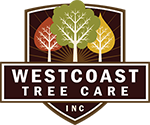Trees are vital to our environment by providing clean air, shade, and beauty. However, just like any living organism, trees can fall prey to diseases that not only threaten their health but can also pose risks to your home and property. That’s why early detection and prevention are key to maintaining healthy trees. As a certified arborist in Monroe, Washington, Westcoast Tree Care would like to share with you the following signs of tree disease and how to prevent them.
Unusual Leaf Discolorations or Patterns
One of a tree’s first and most noticeable signs of disease is unusual leaf discoloration or patterns. Leaves may exhibit yellowing, browning, or unusual spots outside their normal seasonal changes. This could signify various issues, including fungal infections like leaf spot disease or bacterial diseases like fire blight.
Prevention Tips:
- Water properly, ensuring good drainage to avoid waterlogged soil, which can foster fungal growth.
- Prune trees during dormancy to prevent the spread of pathogens.
- Choose disease-resistant tree species or cultivars when planting new trees.
Bark Abnormalities
The bark of a tree is its first line of defense against the environment. If you notice vertical cracks, sunken areas, or a spongy feeling when you press on the bark, these could be signs of cankers or bacterial infections. Peeling bark or the presence of fungal growths like mushrooms at the base of the tree can also indicate decay within a tree.
Prevention Tips:
- Avoid mechanical damage from lawn mowers and weed eaters, which can wound the bark and open pathways for disease.
- Mulch around the base of the tree to maintain soil moisture and provide a barrier against damage.
- Inspect trees regularly for signs of damage or disease and consult with the certified arborist at Westcoast Tree Care if you suspect any issues.
Early Leaf Drop or Defoliation
A healthy tree should retain its leaves throughout the growing season unless it’s deciduous during fall. Premature defoliation or leaves dropping earlier than normal can be a sign of stress or disease, such as anthracnose or root rot.
Prevention Tips:
- Maintain a regular watering schedule, especially during dry spells, to reduce stress on the tree.
- Fertilize appropriately – not all trees need annual fertilization, and too much can do more harm than good.
- Ensure a tree’s root zone is not compacted by heavy equipment or foot traffic, which can impact root health.
Poor Structure or Growth Patterns
Trees with an unusual growth pattern, such as a significant lean to one side or an irregular shape, may be struggling with internal issues. Weak branch unions, where branches are not strongly attached to the tree, can also be a sign of poor tree health.
Prevention Tips:
- Plant new trees in a location where they have room to grow to their full size without obstruction.
- Train young trees with proper pruning to encourage a strong structure.
- Avoid topping trees, which can lead to weak growth and increased susceptibility to disease.
Insect Infestations
Certain insects can be vectors for disease or may be a sign of an already weakened tree. For example, bark beetles often attack trees already in decline. The presence of holes in the bark, sawdust-like frass, or the insects themselves can indicate an insect infestation.
Prevention Tips:
- Keep trees healthy with proper watering, mulching, and pruning as stressed trees are more susceptible to insect attacks.
- Monitor trees regularly for signs of insects and consult the certified arborist at Westcoast Tree Care for appropriate treatment options.
- Use integrated pest management strategies, including biological control agents and less toxic alternatives to traditional pesticides.
Westcoast Tree Care
Regular maintenance, proper care, and early intervention are the keys to preventing tree disease. By being vigilant and taking preventive measures, you can protect your trees from disease and ensure they continue to thrive in your landscape. If you notice any of the signs mentioned above, contact the certified arborists at Westcoast Tree Care by filling out our online form or calling 1.800.767.8733 for a professional evaluation and treatment plan.








